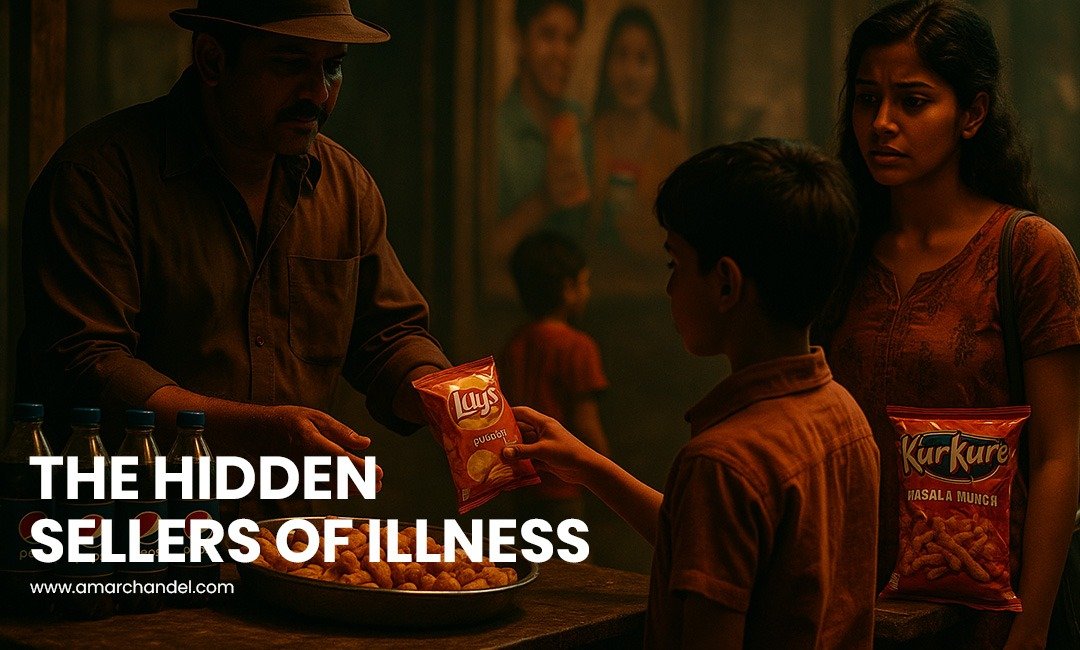Globally—and increasingly in India—fast-food giants spend billions marketing processed foods, sugary drinks, and junk snacks directly to children and families. In India, brands like PepsiCo and multinational snack makers aggressively promote high-sugar, high-fat products as “modern” and aspirational—even claiming benefits like height, energy, and immunity. These claims are misleading and are now recognised as major drivers of obesity and diabetes among youth.
Studies show that by age 9–18, Indian children derive 13–15% of their daily calories from sugar—often exceeding WHO’s 10% guideline—translating into 20–25 teaspoons daily. Weekly fast-food consumption is reported in 70% of schoolchildren, with 40% experiencing weight gain and 25% low energy levels. Advertising, peer influence, and availability play a central role.
Fast Food in Hospitals: A Stark Contradiction
Just as in the U.S., academic pediatric centres in India sometimes feature fast-food outlets or branding on-site. While no detailed Indian hospital audit is public, globally ~30% of teaching hospitals permit fast food inside or display branding, and that exposure increases the perceived acceptability and “healthiness” of the food. The irony is painful: places caring for the sick serve the unhealthy.
India’s Surge in Obesity & Disease Risk
As of NFHS‑5 (2019–21), 6.4% of women and 4.0% of men aged 15–49 are obese, up sharply from NFHS‑4 (2015–16). Among children under five, overweight prevalence rose from 2.1% to 3.4% in that time—a 9.1% projected annual growth in child obesity through 2035. These trends track fast-food expansion (India: ~40% growth/year) and deepening ultra-processed food environments.
The Policy Response: Sugar & Oil Boards in Schools & Public Places
In 2025, the Food Safety and Standards Authority of India (FSSAI) urged states to combat obesity by reducing oil use and promoting healthy diets (“Eat Right India”). CBSE schools must now display “sugar boards” and “oil boards”, showing sugar and fat content in common snacks like samosas, burgers, fries, etc.—designed to educate students and parents visually.
Hospitals should be the last place to promote illness, yet the presence of fast-food branding inside medical institutions suggests complicity. In the U.S., McDonald’s has name rights for “Ronald McDonald Children’s Hospital”, creating positive health connotations. We must ask: should India allow similar branding in hospitals?

We succeeded once in banning tobacco from hospitals—a decades-long public health achievement. Perhaps now is the time to remove fast-food branding and outlets from our healthcare institutions, a symbolic and practical step toward reversing lifestyle disease trends.
• In Hyderabad, gastroenterologists found 50–60% of children in five elite schools suffered from non-alcoholic fatty liver disease (NAFLD), even among 8‑year‑olds, linked to frequent fast-food consumption.
• A study in New Delhi adolescents found 32–34% overweight/obesity, with 85–98% of overweight teens reporting weekly fast-food use—a strong correlation with BMI and inactivity.
• National and local studies confirm that fast-food availability and marketing significantly influence unhealthy choices and contribute to the early onset of obesity and insulin resistance, even in rural areas.
Selling illness inside hospitals is not just a symbolic irony: it’s a public health failure. India faces a growing epidemic of childhood obesity—and fast food marketing, availability—even in schools and hospitals, is a major driver. By reclaiming our healthcare spaces, enforcing smart policies, and reinforcing nutritious traditions, India can reverse course and make health a priority over profit.
Steps India Must Take
1. Ban fast-food outlets and branding inside hospitals—especially pediatric and teaching hospitals.
2. Enforce marketing restrictions, particularly toward children, aligning with WHO guidelines banning junk-food advertising to minors.
3. Promote sugar and oil awareness boards across all schools, hospitals, offices, and public places nationwide—beyond CBSE and Rajasthan pilot schemes.
4. Develop zoning policies restricting fast-food outlet density near schools and hospitals—a strategy showing effectiveness abroad.
5. Support traditional and nutritious meal programmes, like ICDS and PM-POSHAN, to counter ultra‑processed penetration in vulnerable communities.
References
• NFHS‑5 obesity data & projections: NFHS‑5 (2019–21) & World Obesity Atlas 2023
• Fast‑food consumption & obesity studies in India: Gauthaman J (2023), Ranjani et al. (2016), New Delhi adolescent surveys 2024
• Hospital fast‑food branding and its impacts: IJCNPH review, 2006, and global data
• FSSAI directives & CBSE sugar/oil boards: Economic Times, TOI updates May/June 2025
• Pediatric NAFLD in Hyderabad research: TNN Aug 2023
• Marketing and policy research: WHO recommendations, Lancet SEA 2023, and Bassi 2024
• Planning policy evidence on fast‑food density and childhood obesity: Gateshead quasi‑experiment (2024)


Give a Reply